Sicily Road Trip Itinerary – Self Drive
Sicily Road Trip Planner:
After we wrote this post about ‘Things to know before you self-drive in Sicily’, we got a lot of questions about places we traveled across Sicily on our road trip. Yes … we are Sicilian … but we usually travel around our island!
Be it 1 week or 10 days, this itinerary will help you while driving around Sicily and covers most of the beautiful and famous spots in Sicily making it one of the best road trips in Sicily.
With such a pleasing experience, we would recommend that everyone should go road trippin in Sicily at least once in a lifetime! Assisting you in your road trip adventure is your travel buddy. So, here it is – Tour of Sicily
Road trip preparation for self drive holiday:
Well, for a good road trip, what do you need? A reliable and cost effective car and a comfortable place to rest for the day after a long day on the road.
Right?
I know you are nodding your head there. Let me ease this process for you by listing a couple of websites which we always use on our travels.
Car Rental
You can book the car rental using Tour of Sicily, so that we can select the car that matches your taste and budget.
Accomodation
With so many booking sites and hundreds of B&B and Hotels, its indeed difficult to choose the place which suits your taste.
That is where this site comes into picture.
Tour of Sicily has a great selection of hotels which have been used for other clients. We do know their locations, facilities and quality. Furthermore, here in Sicily the hotel rating is completely different from the other side of the world and, because of it, we have created our own rating in:
-3 star properties: moderate and B&B
-4 star properties: moderate, first class, boutique … and a few B&B who are charming and with character
-5 star properties: deluxe, luxury
Self drive Sicily itinerary
We list some places you can visit on your self drive holiday in Sicily.
- Palermo, Capital of Sicily and the Arab-Norman Route
- Monreale and the Mosaics at the Dome
- Cefalù
- Erice, the Marzipan and the Venus Castle
- Salt Way Road between Trapani and Marsala
- Marsala, Saltpans and the Wine
- Selinunte and Belice Nature Reserve
- Agrigento, Kolymbetra Park and Turkish Steps
- Piazza Armerina and the Roman Villa of Casale
- Caltagirone, the Capital of Sicilian Pottery
- Syracusa mainland and Ortigia Island
- Noto Valley: Noto, Ragusa Ibla, Modica, Scicli and the Donnafugata Castle
- Syracusa-Ragusa Nature Parks and Reserves: Pantalica Necropolis, Vendicari and Cavagrande del Cassibile
- Etna Volcano, the most famous highlight of Sicily
- Taormina and Surroundings: Taormina, Castelmola and the Godfather villages (e.g. Savoca)
- UNESCO sites in the entire Sicily
Our Recommended Sicilian Road trip Itinerary
 Let me split the tour in 5 legs
Let me split the tour in 5 legs
First leg of the journey: Palermo
Second leg: Marsala
Thirth leg: Agrigento
Fouth leg: Syracusa
Fifth leg: Taormina
Lets look at each stop and see what we recommend to do there and from there!
Palermo Main Town
You can fly into Palermo and flew out of Catania.
From Palermo airport to join the town you can: catch on the Public Bus —Prestia and Comandè Bus Company — with a very great schedule with departure every 0,30 hour from the airport spending a few euros. You can book the ticket in advance or pay it on the spot.
And, you can also take a Regular Multilingual Walking Tour of Palermo:
-from Tuesday to Sunday, half day h 9AM at eur 38 per person LINK
-from Tuesday to Saturday, half day h 2PM at eur 38 per person LINK
If you are a Meal-Lover do not miss our small size collective Street Food Walking Tour admiring the Massimo Theatre (external view to the Palermo Opera House), then explore a suggestive and lively open-air market, a place with strong Arab influences, resembling a souk, with picturesque stands of fresh fish, cheeses, fruits and vegetables. During the tour you will have the opportunity to observe local people in their daily activities and to savor foods that a real Sicilian people love to eat! Tasting of typical street food is included. The walking tour through the ancient center of Palermo is around 3-4 hours and you will visit several monuments including Piazza Pretoria and the Cathedral. Contact us for it!
What to see and What to do while in Palermo
 When the Jews were expelled in 1492 from all of the dominions of the king of Spain and Aragon (to which Syracuse belonged, together with all of southern Italy), the Jewish community of Syracuse, in the hope of returning one day to their homeland, tried to hide the entrance to their mikvah by completely blocking and camouflaging it.
When the Jews were expelled in 1492 from all of the dominions of the king of Spain and Aragon (to which Syracuse belonged, together with all of southern Italy), the Jewish community of Syracuse, in the hope of returning one day to their homeland, tried to hide the entrance to their mikvah by completely blocking and camouflaging it.
For half a millennium the existence of this space was forgotten. The conversion of to the existing building above the mikvah into a hotel, however, revealed its long access stairway, and the earth (five truckloads!) covering it was removed. Then, the discoverers found the space perfectly preserved yet full of fresh water up to the ceiling.
Mikvah of Syracuse –Ritual Jewish Bath — appears today to visitors as a rectangular principal room, entirely excavated in the limestone rock (to a depth of 18 meters / 59 feet). Its ceiling is supported by four pillars, and the floor is punctuated with three dug baths. Its walls contain three side niches, two of which also feature a bath. One of the side niches intersected a circular well, probably from the Hellenistic period.
An opening in the ceiling provides ventilation and illumination, which runs to the surface next to the current access to the stairs. In the past, the small amount of light provided by this shaft was the only illumination available, save for the addition of oil lamps. Examples of these lamps were found during the excavation and are now displayed in a case in the hotel above.
According to the most recent scholarship, this space may be the most ancient ritual Jewish bath left to us in Europe: the period of construction suggested by scholars is, in fact, the 6th century A.D., in the peak years of the Byzantine period.
For what reasons did the Jewish community of Syracuse take it upon itself to conduct this impressive work? For religious reasons. The water of the mikvah had to be “living water,” that is to say it can ebb and flow without human intervention. The constant subterranean filtration of that depth guaranteed such a characteristic, even in the middle of an island. This was the reason why the this space required such deep excavation into the subsoil: the stagnant water at surface level was not appropriate for ritual use, so the search for an appropriate water source moved deep underground.
Still today, with the out-flowing canal being obstructed by work conducted in modern times, the owner of the hotel has to regularly operate the pumps (obviously not during tours). If this is not done, the water that continuously filters through the walls of the tubs will again fill them.
5. The Fonte Aretusa
 This curious freshwater spring has the peculiarity of flowing right to the seashore. This unusual phenomenon has affected the establishment of the city, which originated on the island of Ortigia in part because of its presence. It since has captured the imagination for millennia, making the reservoir famous in legends and literature.
This curious freshwater spring has the peculiarity of flowing right to the seashore. This unusual phenomenon has affected the establishment of the city, which originated on the island of Ortigia in part because of its presence. It since has captured the imagination for millennia, making the reservoir famous in legends and literature.
Since ancient times the fountain was, in fact, cited by poets and writers (Pindar, Moschus, Ovid, Virgil, and then John Milton, Alexander Pope, Gabriele D’Annunzio), and even inspired the Polish composer Karol Szymanowski.
In ancient Greek myth, the origin of the spring was attributed to the fate of a nymph, Arethusa, who was transformed by the goddess Artemis into a spring to escape the stalking courtship of Alpheus (son of the god Oceanus). He, in despair, was in turn transformed into a river by Zeus and thereby succeeded to finally mix his water with that of Arethusa. The myth probably attempts to explain the brackish taste of the water that results from the infiltration of the bordering sea. Take note that the fountain has changed in appearance many times over the centuries and the last alteration was in 1540 when, constructing ramparts around the island of Ortigia, the Spanish reduced the lake created by the spring of approximately 200 meters to the much smaller, semicircular pool (at the foot of the wall) that one sees now.
These overlying walls were demolished in 1847, with the bases of the ramparts transformed into the Belvedere (redesigned in 1947) that one can admire today.
This pond also has a second peculiarity: at its center a collection of wild papyrus has grown for millennia.
This thicket, together with the similar growths along the Ciane/Anapo river, constitutes the only wild papyrus existing in Europe.
To the delight of youngsters, freshwater fish and domesticated ducks swim in the deep water of the spring.
6. and more important highlights
You can also decide to hire a local guide to visit the town
If you are a Cooking Lover indulge your senses in a half day cooking class with a local chef. Tour of Sicily can book it for you as shown on https://www.tourofsicily.com/tour/taormina-cooking-class-to-learn-from-our-chef/
Taormina Surroundings

1. Etna Volcano
EUROPE’S HIGHEST VOLCANO, Mount Etna is one of most active of the world. Its impressive size ( more than 3327 meters high with an average basal diameter of 40 km) overlooks the whole region.

In relation to the different altitudes and exposure of the slopes, Etna offers a high biodiversity with a rich Mediterranean scrubland and numerous wood species: birches with clear bark, evidence of ancient glaciations,oaks, beeches, pines, brooms of Etna and chestnut trees. In the area of Sant’Alfio we find the oldest and largest tree in Europe, the Hundred Horses Chestnut, awarded with the title of UNESCO Messenger of Peace.
A day tour to spend is necessary and is a must not miss
If you are active and hiker guy do not hesitate to check our amazing Hiking Tour: Etna Hiking and Descent by the volcano ash
If you want to handle the day tour to the Etna Volcano on your own give a look at our blog: https://www.tourofsicily.com/etna-volcano-in-a-pocket/
If vice-versa you are looking us to plan a funny experience including the visit of local wineries and wine tatsings do not use your vehicle but ask us to hire a private WD4X4 Land Rover as shown on https://www.tourofsicily.com/tour/etna-alcantara-gorges-wineries-by-jeep-ride-from-taormina/
2. Castelmola and the Almond Wine

If with a single glance you can you can catch the Ionian coast, the monumental Etna, the Bay of Giardini-Naxos, the Cape of S.Alessio, the strait of Messina and the Calabrian coast, either you are on Google Maps or you are in Castelmola.
This small village above Taormina is a real genuine natural terrace built on the ruins of a Norman castle that, over time has assumed a concave and smooth shape, similar to that of a millstone (grindstone). Therefore, it is easy to guess the origin of the name. It is an instant contraction of “Castle” and “Mola”.
Of the whole fortress we can admire just what remain of the norman walls. A plaque from the tenth century with Greek-Byzantine engravings placed on the façade of the cathedral states: “This castle was built under Costantino, patrician and strategist of Sicily“.
A easy way to join Casstelmola from Taormina is taking the Public Bus who leaves next from Porta Messina –Messina Gate–. Ticket costs a few euros and you can purchase the ticket on the spot or buy the round trip tickets in the bar next to the bus-stop. The ride is around 20 minutes by bus each way.
The square is a mosaic of white lava stone, bordered by tree-lined and shady pavements that open up onto the lookout where you can see Taormina from. In general, the urban design is very nice, the street names, the street numbers and signs are almost always in stone and wrought iron. The doors and windows of the houses are framed in Taormina stone and the houses are covered in light colours ranging from a delicate yellow to antique rose. The Sicilian style roof tiles are still on the roofs and, excluding some questionable buildings from the 60s to 70s, everything is as you would expect from a Sicilian village.
A half day tour to spend in Castelmola
Still on the on the square overlooking the historic Caffè S. Giorgio, founded by monks in 1700. The special feature of this building used as a tavern, in addition to the album that collects the signatures of famous people who have passed through Castelmola since 1907, has the authorship of one of the most distinctive products of the village: the almond wine. Don Vincenzo Blandano, the historical owner of the café, used to welcome people, coming to visit the village. This drink, made with almonds and oranges essences is, probably, one of his invention.
3. Savoca and the Godfather Movie
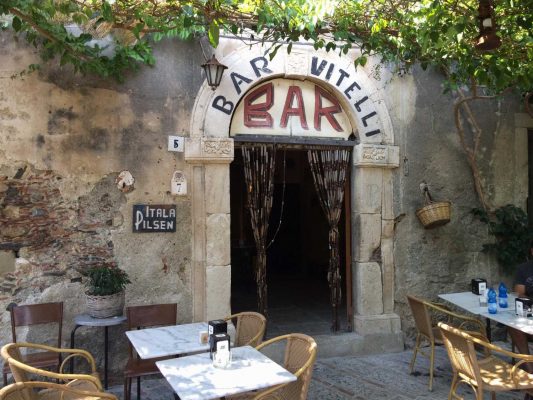 Savoca, is one of the most beautiful villages in Italy, whose name derives from the plant of the elder (savucu in Sicilian dialect), a shrub with white and fragrant flowers that still grows wild in the cracks between houses and which is represented in the medieval coat of arms of the village.
Savoca, is one of the most beautiful villages in Italy, whose name derives from the plant of the elder (savucu in Sicilian dialect), a shrub with white and fragrant flowers that still grows wild in the cracks between houses and which is represented in the medieval coat of arms of the village.
This small town set in the rock of a hill of dual tip, experienced the interest of kings, popes and Archimandrite prelates, in a succession of periods of serious crisis and prosperity. The basalt blocks lying on roads leading between separate small houses, freshly restored with Sicilian tiles on the roofs and windows framed in stone, then following streets in the rock here you’ll find extremely fragmented ruins and old cisterns.
A half day tour is recommended to visit Savoca
Up high, overseeing, are the ruins of the castle Pentefur, a building of questionable origin, perhaps Phoenician, Arab or maybe Norman. It is a bastion which, over time, claimed the title of the Royal Castle, by the will of Philip IV of Sicily. In medieval times, the village of Savoca was surrounded by a wall with double entrance built by the Normans. It is an imposing structure that still remains the City Gate today, a pointed arch made of local stone.
Finally, there is the Church of San Nicolò, which seems almost stretch out into space, built as it is on a massive outcrop of rock. It has three wide aisles and an austere atmosphere of the steep fortress over the valley. The curious thing is that the church was one of the famous sets of the film “the Godfather” along with the Bar Vitelli, housed inside eighteenth century Palazzo Trimarchi. A Byzantine mural has recently been uncovered which depicts St. John Chrysostom, the father of the Christian Church of the East.
If you get to Savoca and you are hungry, you can enjoy typical fresh homemade tagliatelle pasta, dressed with a wild fennel and pork meat ragù sauce or alternatively, the maccarruna, fresh macaroni pasta with pork rind in winter and with aubergine in the summer.
The gastronomy of Savoca, refers to the rural and Sicilian culinary traditions: we can try piscistoccu, dried cod cooked with plenty of extra virgin olive oil, tomato paste, green and black olives, capers, chili, potatoes, celery, u cunzatu breads local homemade bread that is baked in a wood oven and seasoned with extra – virgin olive oil, salt , pepper, to Cuzzola, a fresh pasta sourdough , fried in olive oil and roasted on charcoa. Don’t miss granita ca ‘ zzuccarata is a lemon granita served with zzuccarata,a very crisp local biscuit topped with sesame seeds.
And now we are at the end of our tour. Tomorrow you can self drive to Catania airport and drop your car off.
Hope you have appreciated all teh information shown in the article and feel free to contact Tour of Sicily Tour Operator to customize your tour, decide what to see and what to do, focus all on the gastronomy, wine, experiences, landscape …. as you have read, the island of Sicily has so many important locations which are awaiting for you.

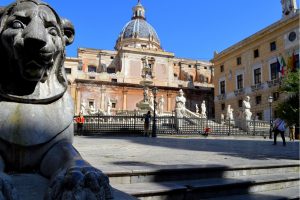
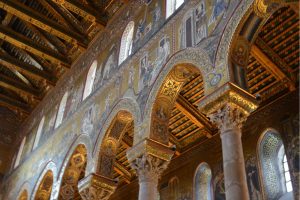 Monreale is a historic hill-town just outside Palermo. It’s a picturesque place most famous for the fine mosaics in the town’s great Norman Cathedral. Monreale is connected to Palermo by regular city buses and is an easy short excursion from the city centre. Although it only takes a couple of hours to visit and see Monreale from Palermo, there are places to eat and drink, good views and a pleasant atmosphere, so you can choose to extend your stay.
Monreale is a historic hill-town just outside Palermo. It’s a picturesque place most famous for the fine mosaics in the town’s great Norman Cathedral. Monreale is connected to Palermo by regular city buses and is an easy short excursion from the city centre. Although it only takes a couple of hours to visit and see Monreale from Palermo, there are places to eat and drink, good views and a pleasant atmosphere, so you can choose to extend your stay.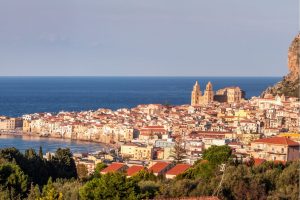 Cefalù, one of the most beautiful villages in Italy, is one of the busiest holiday destinations and resorts on the island. Is located on the northern coast of Sicily, about 70 km from Palermo.
Cefalù, one of the most beautiful villages in Italy, is one of the busiest holiday destinations and resorts on the island. Is located on the northern coast of Sicily, about 70 km from Palermo.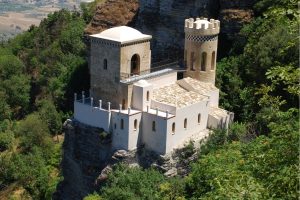 Erice is a pleasant surprise.
Erice is a pleasant surprise. Exploring Erice narrow streets do not forget to stop in a local pastry shop. Personally we do recommend the historical one
Exploring Erice narrow streets do not forget to stop in a local pastry shop. Personally we do recommend the historical one 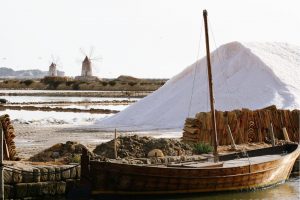 Let’s take the cable car again and join the parking … and drive to Marsala crossing the Salt Way Road, skirting the lagoon to see the snow-capped mountains but hills of salt, one of the Sicilian economy’s historical resources that was already very precious in the days of the Phoenicians, who were the first to bring some form of technology to its production. The favourable climatic circumstances, such as high temperatures and a wind that increases evaporation, plus the shallowness of the water, contribute to create the evocative and unreal scenario created by the salt flats, which form a sort of immense chessboard that ranges in colour from off-green to pink.
Let’s take the cable car again and join the parking … and drive to Marsala crossing the Salt Way Road, skirting the lagoon to see the snow-capped mountains but hills of salt, one of the Sicilian economy’s historical resources that was already very precious in the days of the Phoenicians, who were the first to bring some form of technology to its production. The favourable climatic circumstances, such as high temperatures and a wind that increases evaporation, plus the shallowness of the water, contribute to create the evocative and unreal scenario created by the salt flats, which form a sort of immense chessboard that ranges in colour from off-green to pink. Marsala is internationally famous for one thing: wine!
Marsala is internationally famous for one thing: wine! Today sef drive for the impressive
Today sef drive for the impressive 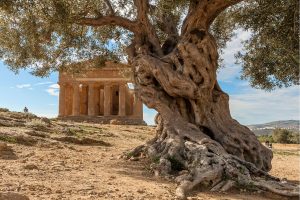 The
The 
 Originally the property of a powerful Roman family, it dates back to the 4th Century A.D.
Originally the property of a powerful Roman family, it dates back to the 4th Century A.D.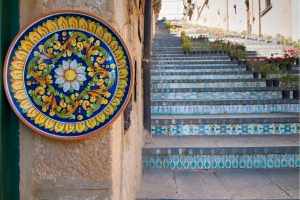 Quietly perched on a mountain connecting the Erei and the Hyblaean Mountains, Caltagirone dominates the two plains of Gela and Catania, which is why all the populations who occupied Sicily throughout history built in the city their most important strongholds. Most famous all over the world for its production of ceramics, first started during the Greek domination, this lovely destination is nowadays appreciated for its remarkable churches and refined palaces and Seventeenth-Century villas: the value of its artistic and monumental heritage has been awarded by UNESCO that listed Caltagirone among the World Heritage Sites back in 2002.
Quietly perched on a mountain connecting the Erei and the Hyblaean Mountains, Caltagirone dominates the two plains of Gela and Catania, which is why all the populations who occupied Sicily throughout history built in the city their most important strongholds. Most famous all over the world for its production of ceramics, first started during the Greek domination, this lovely destination is nowadays appreciated for its remarkable churches and refined palaces and Seventeenth-Century villas: the value of its artistic and monumental heritage has been awarded by UNESCO that listed Caltagirone among the World Heritage Sites back in 2002. Its vast archeological site, on the edge of the modern city, is a rare treasure of temples, amphitheatres and an ancient castle. The island of Ortygia – a labyrinth of charming ancient and medieval streets – makes for a delightful holiday of sightseeing and shopping.
Its vast archeological site, on the edge of the modern city, is a rare treasure of temples, amphitheatres and an ancient castle. The island of Ortygia – a labyrinth of charming ancient and medieval streets – makes for a delightful holiday of sightseeing and shopping.
 Anyone looking for Sicilian food products will find a delicious assortment good enough to turn heads in the market stalls and shops, especially on the seaside, from cheeses to meat to wines and spirits and even expensive spices. For those who are flying, it is best to check with your airline in advance as to the restrictions and regulations for transporting some of these goods (especially liquids, which are not allowed in carry-on baggage, or fresh food, which is not always permitted on certain international flights). Do not forget to try the sheep’s cheese, the cheese with chili peppers, seasoned olives, dried tomatoes . . . all at remarkably affordable prices.
Anyone looking for Sicilian food products will find a delicious assortment good enough to turn heads in the market stalls and shops, especially on the seaside, from cheeses to meat to wines and spirits and even expensive spices. For those who are flying, it is best to check with your airline in advance as to the restrictions and regulations for transporting some of these goods (especially liquids, which are not allowed in carry-on baggage, or fresh food, which is not always permitted on certain international flights). Do not forget to try the sheep’s cheese, the cheese with chili peppers, seasoned olives, dried tomatoes . . . all at remarkably affordable prices.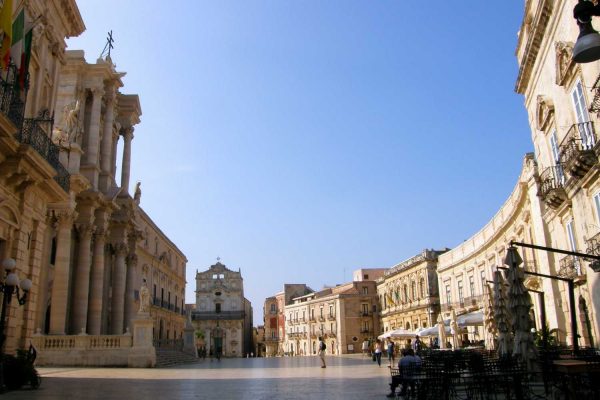 One of the central squares in historic Island of Ortigia is the Piazza del Duomo. The crowning feature of the square is the aforementioned Cathedral, but it also contains some other fantastic structures and is generally an interesting place to explore.
One of the central squares in historic Island of Ortigia is the Piazza del Duomo. The crowning feature of the square is the aforementioned Cathedral, but it also contains some other fantastic structures and is generally an interesting place to explore. The town of
The town of 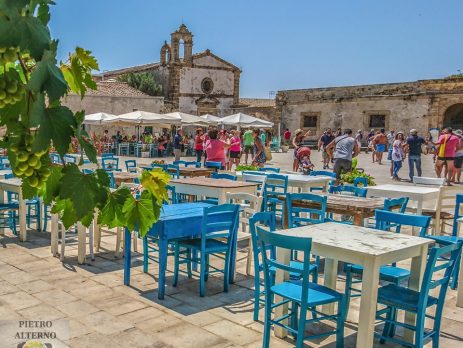
 In Syracuse and with brief excursions in the surrounding area (all within a distance of between 30 and 70 kilometers, or 18 and 43 miles) you can follow the paths of
In Syracuse and with brief excursions in the surrounding area (all within a distance of between 30 and 70 kilometers, or 18 and 43 miles) you can follow the paths of  When the Spanish were ruling Sicily in the 16th Century, conquistadors went to Mexico and brought back cacao and the recipes needed for what the Aztecs called xocoàtl, a paste ground by a smooth round stone called a metate.
When the Spanish were ruling Sicily in the 16th Century, conquistadors went to Mexico and brought back cacao and the recipes needed for what the Aztecs called xocoàtl, a paste ground by a smooth round stone called a metate.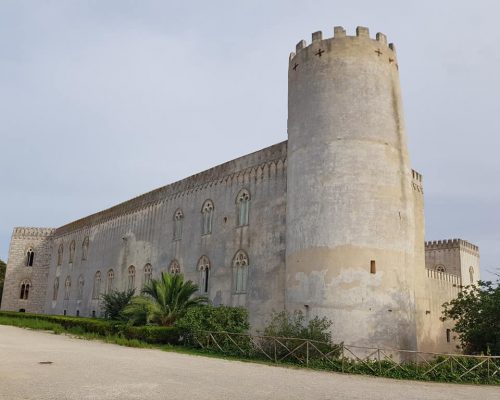
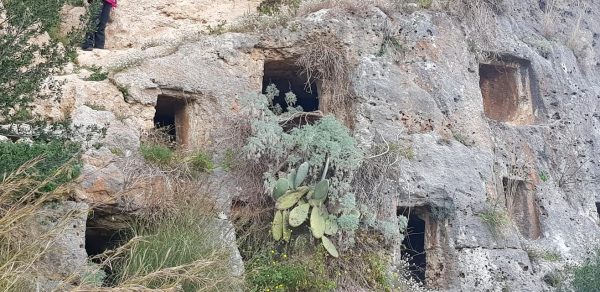 A Unesco World Heritage site, Pantalica is a marvel of Sicily, an archeological and naturalistic masterpiece.
A Unesco World Heritage site, Pantalica is a marvel of Sicily, an archeological and naturalistic masterpiece. 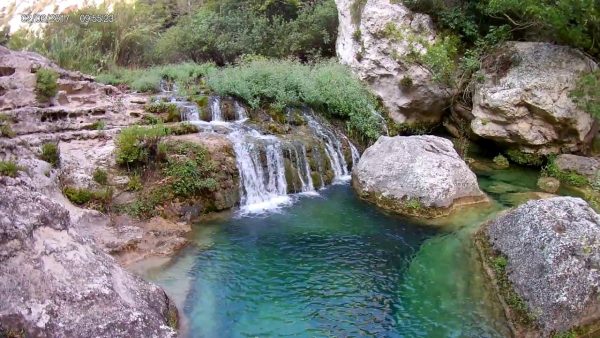 Cavagrande is a protected Natural Reserve in the province of Syracuse (Siracusa), located in the southeast corner of Sicily (the largest Mediterranean island, just off the “toe” of Italy’s “boot”, and World famous for the movie The Godfather).The reserve is known for having one of Europe’s biggest canyons, which is about 10 km long and 300 metres deep. The whole area is surrounded by green colours, ponds, natural pools, waterfalls, limestone steep walls, birds and tiny lizards.
Cavagrande is a protected Natural Reserve in the province of Syracuse (Siracusa), located in the southeast corner of Sicily (the largest Mediterranean island, just off the “toe” of Italy’s “boot”, and World famous for the movie The Godfather).The reserve is known for having one of Europe’s biggest canyons, which is about 10 km long and 300 metres deep. The whole area is surrounded by green colours, ponds, natural pools, waterfalls, limestone steep walls, birds and tiny lizards.

